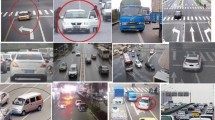Abstract
The lane line detection algorithm is highly sensitive to the environment. And the selection of parameters is greatly affected by human subjective factors. Therefore, the concept of adaptive and dynamic constraint is introduced into the lane line detection algorithm. The evaluation function is set based on the detected information. A high precision lane line detection algorithm with supervision and warning mechanism is proposed. Firstly, the Canny operator gradient calculation method is improved by using eight neighborhood models. And by setting multi-level threshold instead of double threshold detection method, the algorithm’s adaptability is improved. Secondly, the concept of dynamic region of interest is proposed. The detection region of Canny operator is constrained, the environment interference to the algorithm is reduced. Finally, lane line information is included in the supervision and correction warning mechanism. And the early warning is given to drivers. The experimental results show that the algorithm is of high accuracy, real-time and adaptability.














Similar content being viewed by others
References
Aldibaja M, Suganuma N, Yoneda K (2017) Robust intensity based localization method for autonomous driving on snow-wet road surface [J]. IEEE Trans Ind Inform 13(99):1-1. https://doi.org/10.1109/tii.2017.2713836
Bastan M, Bukhari SS, Breuel TM (2016) Active canny: edge detection and recovery with open active contour models [J]. IET Image Process 11(12):1325–1332. https://doi.org/10.1049/iet-ipr.2017.0336
Cai Y, Gao L, Sun X et al (2018) A lane identification method based on morphological features [J]. China Mech Eng 29(15):1863–1868 (in Chinese)
Chen L, Wang Q, Lu X, Cao D, Wang F (2020) Learning driving models from parallel end-to-end driving data set. Proceed IEEE 108(2):262–273. https://doi.org/10.1109/JPROC.2019.2952735
Diwakar M, Kumar M (2018) CT image denoising using NLM and correlation-based wavelet packet thresholding [J]. IET Image Process 12(5):708–715
Duan Z, Li Y, Wang E et al (2016) Road and navigation line detection algorithm from shadow image based on the illumination invariant image [J]. Acta Opt Sin 36(12):206–213 (in Chinese)
Goh TY, Basah SN, Yazid H et al (2018) Performance analysis of image thresholding: Otsu technique [J]. Measurement 114:298–307. https://doi.org/10.1016/j.measurement.2017.09.052
Kumar M, Diwakar M (2018) A review on CT image noise and its denoising [J]. Biomed Signal Proc Control 42:73–88
Lan X, Liu X, Shen H et al (2017) A novel median filter to iteratively remove salt-and-pepper noise from highly corrupted images [J]. Geomat Inform Sci Wuhan Univ 42(12):1731–1737 (in Chinese)
Lei J, Wang L, Yunqian H et al (2017) Image segmentation method for robot vision [J]. Syst Eng Elect 39(07):1653–1659 (in Chinese)
Li C, Cao L, Zhang Y et al (2017) Knowledge-based deep reinforcement learning: a review [J]. Syst Eng Electron 39(11):2603–2613 (in Chinese)
Lin L, Liu Y, Jian W et al (2016) Human dynamics based driver model for autonomous car [J]. IET Intell Transp Syst 10(8):545–554. https://doi.org/10.1049/iet-its.2015.0173
Navarro J, Yousfi E, Deniel J et al (2016) The impact of false warnings on partial and full lane departure warnings effectiveness and acceptance in car driving [J]. Ergonomics 59(12):1553–1564. https://doi.org/10.1080/00140139.2016.1158323
Navarro J, Deniel J, Yousfi E et al (2017) Influence of lane departure warnings onset and reliability on car drivers' behaviors [J]. Appl Ergon 59:123–131. https://doi.org/10.1016/j.apergo.2016.08.010
Ososinski M, Labrosse F (2015) Automatic driving on ill-defined roads: an adaptive, shape-constrained, color-based method [J]. J Field Robot 32(4):504–533. https://doi.org/10.1002/rob.21494
Sebdani FM, Pourghassem H (2012) A robust and real-time road line extraction algorithm using hough transform in intelligent transportation system application. IEEE Int Conf Comp Sci Auto Eng (CSAE), Zhangjiajie. pp. 256–260. https://doi.org/10.1109/CSAE.2012.6272950
Song W, Yang Y, Fu M, Li Y, Wang M (2018) Lane detection and classification for forward collision warning system based on stereo vision. IEEE Sensors J 18(12):5151–5163. https://doi.org/10.1109/JSEN.2018.2832291
Tan D, Chen W, Wang H (2017) On the use of Monte-Carlo simulation and deep fourier neural network in lane departure warning [J]. IEEE Intell Transp Syst Mag 9(4):76–90. https://doi.org/10.1109/mits.2017.2743204
Tao Z, Bonnifait P, Ibanez-Guzman J (2017) Road-centered map-aided localization for driverless cars using single-frequency GNSS receivers [J]. J Field Robot 34(5):1010–1033. https://doi.org/10.1002/rob.21708
Wang Z, Zhao X, Yu H et al (2018) Obstacle detection and obstacle avoidance of AGV based on binocular vision [J]. Comput Integr Manuf Syst 24(02):400–409 (in Chinese)
Wang W, Zhang Z, Gao N et al (2019) Progress of big data analytics methods based on artificial intelligence technology [J]. Comput Integr Manuf Syst 25(03):529–547 (in Chinese)
Xue JR, Wang D, Du SY et al (2017) A vision-centered multi-sensor fusing approach to self-localization and obstacle perception for robotic cars [J]. Front Inform Technol Elect Eng 18(1):122–138. https://doi.org/10.1631/fitee.1601873
Yang P, Song W, Zhao X, Zheng R, Qingge L (2020) An improved Otsu threshold segmentation algorithm [J]. Int J Comput Sci Eng 22(1):146–153
Zhang X, Gao H, Zhao J et al (2018) Overview of deep learning intelligent driving methods [J]. J Tsinghua Univ 58(04):438–444 (in Chinese)
Acknowledgments
This work was funded by the National Natural Science Foundation of China (61303006), Top Talents Program for One Case One Discussion of Shandong Province, National Key Research and Development Program in Shandong Province (2019GNC106127).
Author information
Authors and Affiliations
Corresponding author
Additional information
Publisher’s note
Springer Nature remains neutral with regard to jurisdictional claims in published maps and institutional affiliations.
Chinese Library Classification: TP391.4
Document code: A
Rights and permissions
About this article
Cite this article
Gong, J., Zhang, Y., Sun, K. et al. Adaptive lane line detection and warning algorithm based on dynamic constraint. Multimed Tools Appl 79, 28711–28727 (2020). https://doi.org/10.1007/s11042-020-09472-7
Received:
Revised:
Accepted:
Published:
Issue Date:
DOI: https://doi.org/10.1007/s11042-020-09472-7




